Bangka Belitung Islands
The Bangka Belitung Islands (Indonesian: Kepulauan Bangka Belitung) is a province of Indonesia. Situated off the southeastern coast of Sumatra, the province comprises two main islands, Bangka and Belitung, and several smaller ones. Bangka Belitung is bordered by the Bangka Strait to the west, the Natuna Sea to the north, the Java Sea is to the south, and the Karimata Strait to the east. The province's capital and largest city is Pangkal Pinang. As of the 2015 census, the population of Bangka Belitung was 1,372,813.
Bangka Belitung Islands | |
|---|---|
 Flag  Coat of arms | |
 Location of Bangka Belitung in Indonesia | |
| Coordinates: 2°8′S 106°7′E | |
| Established | 4 December 2000[1] |
| Capital and largest city | Pangkal Pinang |
| Government | |
| • Body | Bangka Belitung Islands Provincial Government |
| • Governor | Erzaldi Rosman Djohan |
| • Vice Governor | Abdul Fatah |
| Area | |
| • Total | 16,424.14 km2 (6,341.40 sq mi) |
| Area rank | 27th in Indonesia |
| Highest elevation | 669 m (2,195 ft) |
| Population | |
| • Total | 1,430,900 |
| • Rank | 29th in Indonesia |
| • Density | 87/km2 (230/sq mi) |
| • Density rank | |
| Demographics | |
| • Ethnic groups | |
| • Religion |
|
| • Languages |
|
| Time zone | UTC+7 (Indonesia Western Time) |
| HDI | |
| HDI rank | 15th in Indonesia (2014) |
| Website | babelprov |
The province has an equatorial climate with tropical rainforests, which however is disappearing due to deforestation. Mount Maras is the highest point in the province and the island of Bangka, with a height of 699 m. There are several rivers in the province, such as the Sebuku River, Baturusa River and Mendo River. The province is ethnically, culturally, and linguistically diverse; major ethnic groups including Malays, Chinese and Javanese. Indonesian is the official language of the province, while the local Malay dialect and Hakka serves as the lingua franca of the province.
Historically, Bangka Belitung has been part of the kingdoms of Sriwijaya, Majapahit and Palembang, before becoming a colony of foreign empires (Dutch, British, and Japanese). Bangka Belitung was a residency within the Dutch East Indies. Upon the independence of Indonesia, the region was administered under the province of Sumatra and South Sumatra. Bangka Belitung officially became the 31st province of Indonesia in 2000.
Etymology
The name "Bangka" is derived from the word wangka (वन्च 'vanca') meaning "tin" in Sanskrit, because this region is indeed rich in tin mining. The name "Wangka" first appeared along with the name "Swarnabhumi" in the Indian literary book Milindrapantha from the 1st Century BC. Swarnabhumi is identified as the island of Sumatra, the strong allegation that the so-called "Wangka" is the island of Bangka. Louis-Charles Damais, in his book Epigraphy and History of the Nusantara, affirms that Bangka comes from the word vowel (vanca).
The name "Belitung" is derived from Billitonite meaning the Black Meteorite in Dutch, which is commonly found in the island of Belitung. This stone itself was discovered at the time of tin mining in Belitung. Later on, Dutch academics writing in East Indies publications began named the island Billitonite or Billiton. Nowadays, Billitonite or Black Meteorite, is a distinct souvenir from Belitung Island.
History
![]()
![]()
![]()
![]()
![]()
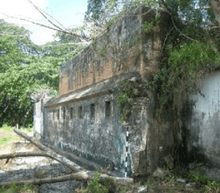
Bangka Belitung is an area that has a unique range of cultures and languages. Just like other provinces in Indonesia, Bangka Belitung has served as European and Japanese colonies. Prior to the colonies era, Bangka Belitung has become part of several kingdoms in Sumatra and Java. Sriwijaya and Majapahit are the kingdoms who settled Bangka Belitung to expand its power.
The first Europeans arrived in Bangka was the English on 20 May 1812. However, with the Anglo-Dutch Treaty of 1824, English left Bangka Belitung, and the Dutch took over. Due to the agreement, the Dutch were able to take control of the Pacific Islands. However, there is a coup attempt by local élite through Depati Barin and his son Depati Amir who was well known with the war of Depati Amir with wartime of about three years (1849-1851) to oppose the colonization in Bangka Belitung. Yet, this war was then won by the Dutch and that caused Depati Amir to be exiled to Kupang in East Nusa Tenggara. Therefore, Depati Amir became a national hero and her name was remembered through its regional airport, the Depati Amir Airport.
Bangka Belitung has a long history with Chinese migration (mainly Hakka people). Chinese people in the 13th century had already started to migrate into the Bangka region. In the 17th century, the rulers of Palembang saw there was extraordinary potential which later they found tin mines in Belitung. The tin is the most reason why the Dutch decided to bring contract workers from mainland China that resettled in Belitung. The tin itself what helped drive the island's development and make it the place it is today. Since then, some of Chinese migrants have gone home while others decided to stay. The one who decided staying began assimilating with local people and is followed by intermarriages, they live coexisting peacefully in spite of differences in religion and ethnicity. When anti-Chinese riots occurred in some parts of Indonesia at the end of the Soeharto regime in 1998, the locals and those of Chinese descent not much concerned and still lived peacefully in the Bangka Belitung province.[6]
Bangka Belitung province is created as the 31st province by the Government of the Republic of Indonesia based on Law No. 27 of 2000 on the establishment of Bangka Belitung province which was part of the South Sumatra province. The provincial capital is Pangkalpinang.[7]
Weather and Climate
In 2007 the moisture in the Bangka Belitung Province ranged from 77.4% to 87.3% with an average monthly reach of 83.1%, with a rainfall of 58.3 mm to 476.3 mm and air pressure during 2007 approximately 1010.1 MBS. The average temperature during 2007 in the province reached 26.7 °C with an average maximum temperature of 29.9 °C and average minimum temperature of 24.9 °C. The maximum air temperature was highest in October, with temperatures of 31.7 °C, while the minimum temperature was lowest in February and March with temperatures of 23.2 °C.
Bangka Belitung Islands have tropical climate influenced monsoons are experiencing a wet month for seven months throughout the year and dry month for five months continuously. In 2007 the dry months occurred in August to October with rainy days 11–15 days per month. For the month of wet rainy days 16–27 days per month, occurred in January to July and November to December.
Geography
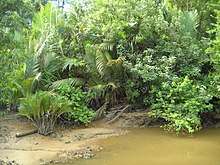
Bangka Belitung is entirely surrounded by water. It is bordered by Natuna Sea to the north, Karimata Strait to the east, Java Sea to the south, and Bangka Strait to the west. The natural state of Bangka Belitung Province is largely a plateau, valley and a small portion of the mountains and hills. Lowland altitude average of about 50 meters above sea level and altitude mountain areas among others to Mount Maras reach 699 meters in Belinyu District, Bangka. Mount Tajam Kaki height is approximately 500 meters above sea level on the island of Belitung. As for the hilly areas like Bukit Menumbing reaches a height of approximately 445 meters in the Bukit Nenas and Mangkol district with a height of about 395 meters above sea level in the Pangkalan Baru district. Soil in Bangka Belitung generally have a pH or acidic soil reaction averaging below 5, but has a very high aluminum content. Within it are various minerals, such as tin, sand, quartz sand, granite, kaolin, clay, and others.
The province is connected by sea waters and small islands. Overall land and water Bangka Belitung is an integral part of the plains of Sunda, so that its waters are part of the Sunda Shelf with a sea depth of no more than 30 meters. As the water area, Bangka Belitung has two types of waters, namely the open waters and semi-enclosed waters. Open water contained around Bangka island located to the north, east and south of the island of Bangka. While there is a semi-enclosed waters in the straits and bays Kelabat Bangka in Bangka North. Waters on the island of Belitung is generally open. In addition, as the territorial waters of the sea, the area of Bangka Belitung Island also has many rivers such as Baturusa, Layang, Manise, and Kurau rivers.
Bangka Belitung has various kinds of quality wood that is traded outside the region, such as pelawan, meranti, ramin, mambalong, mandaru, bulin and kerengas. Other forest plants found in the island are keramunting, buk-buk, mate ayem, kapuk, jelutung, pulai, gelam, meranti rawa, mentagor, mahang, various species of mangrove, and others. Other forest products are natural honey and rattan. Bangka Belitung is also known for its bitter honey. Fauna in Bangka Belitung have more common similarities with the fauna in the Riau Archipelago and Peninsular Malaysia than with Sumatra. Some of the animals that can be found in Bangka Belitung are deer, wild boar, beruk, eagle, weasel, and hare, among others.
Economy
In 2007, GDP at current prices in Bangka Belitung province with oil and gas amounted to 17,895,017 million, while the GDP without oil and gas amounted to 17,369,399 million. When compared with the previous year showed an increase where in 2006 the GDP at current prices with the oil and gas is 15,920,529 million and the GDP without oil and gas amounted to 15,299,647 million. Likewise, GDP at constant 2000 prices, either with or without oil and gas in 2007 showed an increase. The rate of economic growth in Bangka Belitung province in 2007 has improved compared to 2006. Based on the calculation of GDP at constant 2000 prices, the economic growth rate in 2007 with oil and gas is about 4.54 percent and non-oil economic growth is around 5.37 percent. The value of GDP at 2000 constant prices in 2006 with oil and gas is 9,053,906 million in 2007 increased to 9,645,062 million, while without the oil and gas into 9,257,539 million.
The economy in Bangka Belitung Province in 2007 is supported by the primary sector and secondary sector. The primary sector includes agriculture and mining and quarrying. The primary sector has a considerable contribution each by 18.67 percent and 20.40 percent. While in the secondary sector, namely the manufacturing sector provides a sizeable contribution in the GDP Bangka Belitung province that is equal to 22.51 per cent and for electricity, gas and water supply and construction sectors each contributed 0.65 percent and 5, 87 percent. For the tertiary sector is trade, hotel and restaurant sector, transport and communications, financial services, leasing and business services sector and the services sector has accounted for 34.81 percent. In terms of the use of GDP at current prices is used for household consumption. In 2007 the amount of household consumption expenditure amounted to 9,015,057 million or about 50.38 percent of total GDP. Besides foreign trade activities also have a substantial contribution to exports worth 8,741,217 million or 48.84 percent and for imports were valued at 5,284,414 million or 29.53 percent of total GDP.
The balance of trade which include exports and imports of Bangka Belitung province in 2007 increased the value of the surplus from the previous year. The value of exports in 2007 reached 1254.43 million US dollars, up 17.38 percent over the previous year. While the value of imports declined from 25.09 million US dollars in 2006 to 21.58 million in 2007 or a decrease of 16.27 percent. The amount of trade surplus in 2007 amounted to 1232.85 million US dollars. Thus the surplus value in 2007 increased by 18.13 percent.
Industry
In 2007, Bangka Belitung province dominated by the chemical industry and building materials in quantity, as many as 1187 business units spread across the districts / cities, mostly in Central Bangka regency with 339 business units. Employment in the industrial sector reached 19 462 people where 7375 is the largest employment were in the group of metal machinery and electronics industry. Handicraft industry in Bangka Belitung Islands is a result of agro industry processing industry, fishery, agriculture and marine products. Industry craft cultivated population are hand crafted pewter industry in the form of tin, bracelet / ring / stick from the root bahar, woven cap / cap resam and so on. While the craft industry in the form of food / confectionary in the form of paste, rusip, brittle / crackers, and others.
Health
According to the Indonesian Health Department, Bangka Belitung is highly malarious area, with an annual malaria incidence rate of 29.3/1000 population.[8]
Administrative divisions
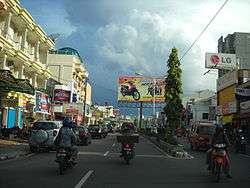

Bangka Belitung is divided into six regencies and one city, below with their (provisional) populations at the 2010 Census and at the most recent 2017.
| Name | Area (km2) | Population Estimate 2005 | Population Census 2010 | Population 2017 | Capital | HDI[9] 2014 Estimates |
|---|---|---|---|---|---|---|
| Pangkal Pinang City | 118.80 | 145,945 | 174,838 | 200,326 | Pangkal Pinang | 0.762 (High) |
| Bangka Regency | 2,950.69 | 246,579 | 277,193 | 317,735 | Sungailiat | 0.697 (Medium) |
| Central Bangka Regency (Bangka Tengah) | 2,126.36 | 133,380 | 161,075 | 184,720 | Koba | 0.680 (Medium) |
| South Bangka Regency (Bangka Selatan) | 3,607.08 | 148,912 | 172,476 | 197,670 | Toboali | 0.635 (Medium) |
| West Bangka Regency (Bangka Barat) | 2,820.61 | 147,855 | 175,110 | 200,684 | Muntok | 0.664 (Medium) |
| Total Bangka | 11,623.54 | 822,671 | 960,692 | 1,101,135 | ||
| Belitung Regency | 2,293.69 | 132,777 | 155,925 | 178,721 | Tanjung Pandan | 0.695 (Medium) |
| East Belitung Regency (Belitung Timur) | 2,506.91 | 87,380 | 106,432 | 121,971 | Manggar | 0.681 (Medium) |
| Total Belitung | 4,800.60 | 220,157 | 262,357 | 300,692 |
Tourism
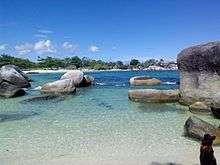
Bangka Belitung has numerous beaches and several small islands. Some beaches are famous for their natural attractiveness with blue sea waters, variety of coral reefs, white sand, and giant granite rock formations. Thus, Bangka Belitung beaches have attracted tourists from around the world. Some of the well-known beaches in Bangka Island are Pasir Padi, Matras, Parai Tenggiri, Tanjung Pesona, Rambak, Teluk Limau, Teluk Uber, Tanjung Penyusuk, Tanjung Kalian, and Tanjung Kerasak.[10]
Some of the beaches in Belitung Island are Tanjung Kiras, Tanjung Pendam, Tanjung Tinggi, Tanjung Kelayang Beach, Tanjung Binga, Panyaeran Beach, Tanjung Kubu, Teluk Gembira, and Tanjung Ru Beach. Most of the beaches in Belitung features the sites for diving, scuba, snorkeling, fishing and sailing.[11]
| Year | Pop. | ±% |
|---|---|---|
| 1971 | 507,231 | — |
| 1980 | 653,897 | +28.9% |
| 1990 | 822,900 | +25.8% |
| 2000 | 900,197 | +9.4% |
| 2010 | 1,223,296 | +35.9% |
| 2017 | 1,401,827 | +14.6% |
| Source: Statistics Indonesia 2010. Bangka Belitung part of South Sumatra Province until 2000 | ||
Demographics
The population of Bangka Belitung Province in 2010 (SP2010) amounted to 1,223,296 inhabitants showed 36.06 percent increase from 2000, with a population of 899 095 inhabitants (the results of the 2000 Population Census). The local Malay who lived in the province are locally called "Melayu Bangka Belitung".[13]
Number of male population in 2010 about 635 094 inhabitants and a population of 588 202 inhabitants as much as women. The sex ratio of the same year amounted to 108, meaning that in 2010 for every 208 residents in Bangka Belitung there are 100 women and 108 residents of the male population. Population growth rates Bangka Belitung province in 2010 amounted to 2.83 per cent, if the review by district / city for the period of 2010, the growth rate is highest in Bangka Tengah 3,43 percent, followed by 3.06 percent and the City Pangkalpinang Bangka District 2,79 percent. The number of households in Bangka Belitung in 2010 about 311 145 households and counties that have the largest number of households is Bangka amounted to 70 468 households and who have the lowest number of households is East Belitung amounted to 27 941 households.
The population density Bangka Belitung province reached 74 people per km2, when seen by district / city, Pangkalpinang has the highest density of 1,471 people per km2 and East Belitung province has the lowest density is 42 people per km2.
Ethnicity
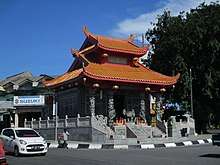
The inhabitants of Bangka Island and Belitung Island originally inhabited by the Orang Laut, in the course of a long history formed the process of culture and acculturation. The Orang Laut themselves came from various islands. Sea people from Belitung sail and inhabit the coast along the Malay Peninsula, then returned to Bangka Island and Belitung Island. While those who live in Riau Islands sail to Bangka. There are also groups of Orang Laut from Sulawesi and Kalimantan. In the next wave, the Bugis, who was originally from South Sulawesi, came and settled in Bangka, Belitung and Riau. Then came the Johor Malay, Siantan Malay, Malay-Chinese, and also native Chinese, mingling in the process of acculturation and culture. Then came the Minangkabau, Javanese, Banjarese, Madurese, Acehnese and some other ethnic groups.
The Malay is the largest ethnic group in the province. They form around 52.5% of the total population. The Malays are mostly concentrated around the interior of Bangka and Belitung. The Malay are divided into the Bangka Malay and the Belitung Malay. These 2 group are slightly different ranging from their culture to their language. Most of the Malays works in either the farming industry or the fishing industry. The Malay in Bangka Belitung have a very distinct lifestyle compared to other Malay people, especially with those in Malaysia. Another group of Malay inhabiting Bangka Belitung is known as the Orang Laut. They inhabit the coastal part of the province and are usually nomadic, living in one place or another.
The second largest ethnic group is the Chinese, forming around 29.1% of the total population. The Chinese are mostly concentrated in the coastal part of Bangka and Belitung or urban areas. The Chinese in Bangka Belitung are originally from Southern China, especially the Guangdong province, migrating from the 18th century to the early 20th century to have a better job opportunities. During the colonial era, most of the Chinese works in the mining industry as well as making their own business. Most of the Chinese in Bangka Belitung are Hakka, while significant Hokkien and Cantonese community also exist. The Chinese culture in Bangka is slightly different from the Chinese in Belitung. The Chinese in Bangka were imported in the early 18th century when the mine was officially opened. They generally did not bring their wives to marry indigenous people, so the Chinese in Bangka are mostly peranakans who speak Hakka Language mixed with Malay. Belitung Chinese are considered "totok" because it came in the 19th century brought the wife. They adapt to the culture of the archipelago, among others, by changing their clothing with local clothing such as clothes with kebaya kurung or sarong. They still speak with the original Hakka language spoken in China today.
The rest of the population consist of immigrants from other parts of Indonesia such as the Javanese, Minangkabau and the Bugis.
Employment
The population of Bangka Belitung Islands aged 15 years and above or which includes the Working Age Population (PUK) in 2007 as many as 766,428 people or 69.25 percent of the total population. 66.78 percent of the PUK is included in the workforce population (working and / or seeking employment) and the remaining 33.72 percent are non-workforce residents (schools, taking care of households and others). The labor force participation rate of Bangka Belitung Islands in 2007 amounted to 66.28 percent meaning that 66 percent of the working age population is economically active. The open unemployment rate for the Bangka Belitung Islands in the same year amounted to 6.49 percent, meaning that out of 100 people including the labor force, on average 5-6 people are job seekers. The working age population when viewed from the employment sector shows that as much as 34.4 percent of the working age working population is absorbed in the agricultural sector, 20.9 percent is absorbed by the mining sector and the trade sector absorbs 18.7 percent.
Religion
Based on the Population Census in 2015, the percentage of religion in Bangka Belitung Islands is Muslim 88.71%, Buddhist 4.49%, Christianity 3.37% (Protestant 2.06% and Roman Catholic 1.31%), Confucian 3.30% and Hindu 0.09%.
Bangka Belitung has 730 mosques, 87 Protestant churches, 30 Catholic churches and 48 monasteries. Number of pilgrims registered and departed to Mecca in 2007 as many as 1012 pilgrims.
Education
The history of universities in Bangka Belitung was initiated by the inauguration of Sriwijaya Bangka Bangka University in 1970s. But in accordance with the regulations that did not allow state universities to open branches, then in the early 1980s the university was closed. The educators in Bangka Island who care about the importance of higher education then initiated the presence of universities in Bangka by forming the Foundation of Education Bangka (Yapertiba) which later in 1982 founded STIH Pertiba with the Department of Law and STIE Pertiba with Management majors located in Pangkalpinang City. Yapertiba also established STAI Bangka located in Sungailiat City. PT. Timah Tbk. participated in developing the world of higher education by establishing Polytechnic of Tin Manufacturing in 1994 located in Sungailiat City which has 3 majors. In the 1990s, Pangkalpinang City Government took part in establishing the Nursing Academy to produce reliable health workers in accordance with the needs of the region located in Pangkalpinang District Hospital. Yapertiba in 1999 established STIPER Bangka located in Sungailiat City in 1999, then STIPER Bangka in 2006 merged into part of University of Bangka Belitung. In 1999 also stands Bakti Accounting Academy founded by Yayasan Pendidikan Bakti.
In Belitung Island a number of educational observers in 1999 established the Belitung Management Academy. STIE IBEK Babel was also present to enliven the world of higher education in Bangka which was established in 2000 located in Pangkalpinang City with majoring in Accounting and Management. In 2001 AMIK Atma Luhur stood in Pangkalpinang City with a specialty in informatics expertise, has 2 majors namely Management Informatics and Computer Accounting. In the same year STIKES Abdi Nusa was also present at Pangkalpinang with Public Health department. In 2003 the Stisipol Pahlawan 12 and TT Pahlawan 12 were established in Sungailiat City. The Ministry of Religious Affairs in 2005 established STAIN Syekh Abdurrahman Sidik located in West Mendo District. In 2006 stood the first university in Bangka Belitung namely University of Bangka Belitung (UBB) which is the forerunner to the establishment of a state university in Bangka Belitung. UBB is a merger of 3 universities namely Polman Timah, STIPER Bangka and STT Heroes 12. In February 2009 UBB officially became a state university with the signing of MoU submission of all UBB assets from Yayasan Cendikia Bangka to Dirjen Dikti Depdiknas.
References
- "Undang-Undang Republik Indonesia Nomor 27 Tahun 2000" (PDF). dpr.go.id (in Indonesian). People's Representative Council. Retrieved 9 March 2020.
- "Statistik Indonesia 2018". Badan Pusat Statistik. Retrieved July 23, 2018.
- Central Bureau of Statistics: Census 2010 Archived 2017-11-20 at the Wayback Machine, retrieved 17 January 2011 (in Indonesian)
- "Kewarganegaraan, Suku Bangsa, Agama dan Bahasa Sehari-hari Penduduk Indonesia 2010". BPS Indonesia. Retrieved 14 July 2018.
- "Population by Area and Religion of Bangka Belitung 2010" Retrieved 13 July 2018
- "Heaven on earth in Bangka Belitung". February 8, 2012.
- "Provinsi Kepulauan Bangka Belitung - Bumi Serumpun Sebalai". www.babelprov.go.id. Retrieved 19 November 2018.
- Indonesia Health Map 2007, Department of Health, Government of Indonesia.
- Indeks-Pembangunan-Manusia-2014
- "Archived copy". Archived from the original on 2015-02-06. Retrieved 2015-03-17.CS1 maint: archived copy as title (link)
- antaranews.com. "SWB 2011 to become biggest international marine event - ANTARA News". Retrieved 19 November 2018.
- "Population by Region and Religion in Indonesia". BPS. 2010.
- A. J. Gooszen, Koninklijk Instituut voor Taal-, Land- en Volkenkunde (Netherlands), A demographic history of the Indonesian archipelago, 1880-1942, KITLV Press, 1999, ISBN 978-90-6718-128-0
Further reading
- Somers Heidhues, Mary F.(1992)Bangka tin and Mentok pepper : Chinese settlement on an Indonesian island Singapore : Social Isuues in Southeast Asia, Institute of Southeast Asian Studies. ISBN 981-3035-99-4
